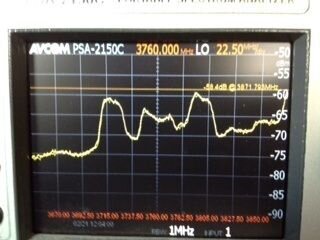I'm having a really rough time pulling Nasa-TV in on AMC-18 (3760V). I have tried several different receivers, replaced a few suspect F-connectors and even a fresh run of RG-6. The dish is a Sami 10ft with a Dual-Ortho feed. C-Band LNBS are Norsat 8115's. NBC on horizontal comes in fine. Along with all the DC-II stuff on both Vertical and Horizontal. Everything else across the arc looks great with nice signals and plots on the Spec An. Except for Nasa. In the attached photo you'll noticed how ragged it looks as opposed to the nice haystacks on either side. The only thing I don't have a spare to try is the LNB but then again everything else looks great from East to West! The other somewhat strange thing is that at night the signal starts to pop in on the Azbox right at threshold about 32 quality. Any suggestions are appreciated.
AMC-18 Nasa-TV Problem
- Thread starter ParaclipseCKu
- Start date
- Latest activity Latest activity:
- Replies 11
- Views 3K
You are using an out of date browser. It may not display this or other websites correctly.
You should upgrade or use an alternative browser.
You should upgrade or use an alternative browser.
- Status
- Please reply by conversation.
Actually surprised you're having this problem with a 10ft. I've seen others with 6's, yes, but not a 10. Ok, here's my 2¢ - FWIW
While watching the spectrum plot, have you tried moving the dish a click or 2 E or W? 3740 V 29270 on 103 interfering? FWIW, how does 3740 V 29270 on 103 work? If it is Sidelobe/adjacent interference. Improvement may be had by changing the F/D setting of the scalar to something other than what is calculated. +.04 or so I would think would be the limits before overall degradation is noticed. Just might be something to try.
While watching the spectrum plot, have you tried moving the dish a click or 2 E or W? 3740 V 29270 on 103 interfering? FWIW, how does 3740 V 29270 on 103 work? If it is Sidelobe/adjacent interference. Improvement may be had by changing the F/D setting of the scalar to something other than what is calculated. +.04 or so I would think would be the limits before overall degradation is noticed. Just might be something to try.
Thanks for the suggestion. 3740V on AMC-1 comes in just fine. I notice no improvement moving a few clicks. I will try the F/D adjustment and see what happens. I tried adjusting the F/D ratio slightly with no improvement. Also tried the skew slightly again no improvement.
Last edited:
I think I'm stumped. Only thing left is the LNB(?) FWIW- How does 3760 H on 137W look? There is 3780 H on 135W. Same freq with a +20 MegHz adjacent TP, just on the other polarity. Don't know exactly what I'm looking for, maybe just a clue. Guess I'm just grabbing at straw. Shoot- just saw you only get to 135.
That is the same conclusion I reached! Can't think of anything else. If they had only stayed on SES-2! Thanks for the suggestions. I do miss getting 137W and 139W but its a whole lot easier working on the ground than at the peak of the roof with the old Paraclipse!
As has happened for the last week or so. Once it got dark, Nasa popped in just above threshold on the Azbox. Temperature hasn't dropped off all that much down about 5 degrees from the daytime high of the low 40s.
Have you tried swapping the lnbs ? If it is an lnb issue it's unlikely that they both have the same problem.Plus while you have it apart you can check for moisture,critters etc.
Now why didn't I think of that! May have to wait until next week to try that. Back to work tomorrow! Appreciate the suggestion 
I just scanned that in today, also with a SAMI 10' dish, getting good stable signal this morning. You might be having a weak lnb, if it improves when the sun goes down (less noise in the sky). Or maybe some TI from somewhere??
I wish they'd stayed where they were too!!
I wish they'd stayed where they were too!!
Couldn't have said it better myself! Turbosat I hope you are right. Nasa was the reason I put up my first dish in '87 and even without manned flights right now (and dare I say the internet) I just plain miss having easy access to it !
Interfering signal most likely TI. Some signal sources have to power down at sunset. Also possibly the signal is just bad, NASA is not what it used to be. If it is clean on your end, as it increasingly appears to be, the problem is not on your end.As has happened for the last week or so. Once it got dark, Nasa popped in just above threshold on the Azbox. Temperature hasn't dropped off all that much down about 5 degrees from the daytime high of the low 40s.
Schedule and the weather cooperated today and I made some adjustments. I re-skewed the feedhorn by 180 degrees and sure enough that made just enough difference to actually get a good lock during the day. I also made a slight adjustment in my elevation so I'm now have a Q of 40 on the Az which gives me a very little bit of margin. On the spec an I improved from -63db to 59db. Still not what I'd like to have but moving in the right direction!
- Status
- Please reply by conversation.
Similar threads
- Replies
- 1
- Views
- 110
- Replies
- 8
- Views
- 1K
- Replies
- 2
- Views
- 964
- Replies
- 9
- Views
- 2K


